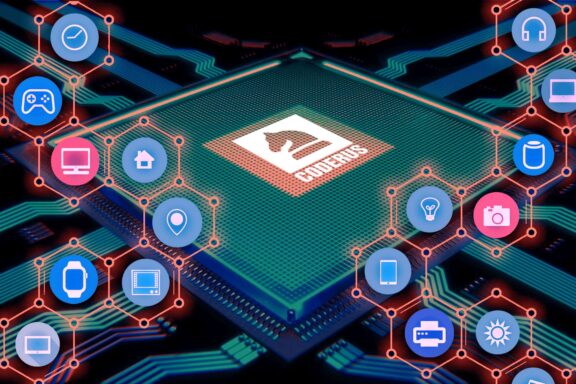

Embedded systems are a lot more common than you might think, and exist in most of the products we use in everyday life. Have a look at 50 real-world examples of embedded systems here – or check out our blog on what embedded systems are and how they work here.
Embedded systems in smartwatches combine sensors, processors, and wireless connectivity to track health data, display notifications, and interact with smartphones.
Fitness trackers like smart watches etc. use embedded systems to monitor physical activity, heart rate, and sleep patterns, providing users with valuable health insights.
Embedded systems in home automation systems control and automate various aspects of a home, such as lighting, temperature, security, and entertainment systems.
Embedded systems in medical devices monitor and regulate vital functions, delivering precise treatments as required.
Embedded systems in automotive systems manage engine performance, vehicle diagnostics, and provide entertainment and navigation features.
Embedded systems in industrial robots enable precise control and coordination of robotic arms, facilitating automation in manufacturing processes.
Air conditioning systems use embedded controllers to regulate temperature, fan speed, and air quality based on user preferences and environmental conditions.
Embedded systems in digital cameras process image data, control camera settings, and enable features such as autofocus and image stabilization.
Embedded systems in drones manage flight controls, stabilise the aircraft, process sensor data, and facilitate communication with ground control.
Traffic light control sytems use embedded controllers to manage traffic flow, adjusting signal timings based on traffic conditions.
Embedded systems in security systems power surveillance cameras, process video feeds, and control access to secure areas.
Embedded systems in GPS devices receive satellite signals, calculate routes, and provide turn-by-turn navigation instructions.
Embedded systems in voting machines ensure accurate vote recording, security, and tallying of results.
Wearable health monitors use embedded systems to track vital signs, activity levels, and provide feedback to users for health monitoring.
Embedded systems in POS systems manage transactions, inventory control, and integration with payment systems.
Embedded systems in barcode scanners process barcode data, decode it, and provide product information for inventory management and retail operations.
Digital thermometers use embedded systems to measure temperature accurately and display readings in real-time.
Embedded systems in automatic doors control sensors, motors, and safety mechanisms to open and close doors based on proximity or user input.
Embedded systems in satellite communication enable data transmission, reception, and control for various applications.
Embedded systems in ATM machines manage transaction processing, user authentication, and cash dispensing in automated teller machines.
Embedded systems in digital audio players decode audio files, handle user interfaces, and control audio playback features.
Home theatre systems use embedded controllers to manage audio/video inputs, outputs, and provide immersive entertainment experiences.
Embedded systems in gaming consoles handle graphics rendering, user input, and game logic for an interactive gaming experience.
Embedded systems in electronic cash registers facilitate transaction processing, inventory management, and receipt printing.
Smart refrigerators use embedded systems to monitor food inventory, manage temperature settings, and provide smart features like recipe suggestions.
Embedded systems in elevator control systems manage elevator operations, including floor selection, motor control, and safety mechanisms.
Embedded systems in solar inverters convert DC power generated by solar panels into AC power for use in homes or businesses.
Embedded systems in industrial control systems control and monitor industrial processes, such as manufacturing assembly lines or power
Embedded systems in electronic locks use authentication methods such as keycards or biometrics to control access to doors or safes.
Embedded systems in fire alarms monitor smoke or heat levels and trigger alarms or alerts to warn occupants and initiate emergency response.
Embedded systems in traffic monitoring systems collect and process data from sensors or cameras to monitor traffic flow and detect anomalies.
Electronic toll collection systems use embedded devices to detect and process toll payments electronically, improving efficiency and reducing congestion.
Embedded systems in aircraft control various flight parameters, including navigation, stability, and autopilot functions.
Embedded systems control railway signaling, ensuring safe and efficient train operations, including traffic control and train movement.
Embedded systems in spacecraft manage various functions in spacecraft, including navigation, communication, power management, and data collection.
Embedded systems in microwave ovens control power levels, cooking time, and sensor-based features to heat food efficiently and safely.
Embedded systems in electronic scales measure weight accurately and display readings for applications such as food portioning or weighing packages.
Embedded systems in robot vacuum cleaners navigate the environment, detect obstacles, and clean floors autonomously or according to user settings.
Embedded systems in wireless sensor networks collect data from distributed sensors, transmit it wirelessly, and enable remote monitoring and control.
Embedded systems in pacemakers monitor heart activity and deliver electrical pulses to regulate heart rhythm and ensure proper functioning.
Blood glucose monitors use embedded systems to measure blood glucose levels, provide readings, and help individuals manage diabetes.
Embedded systems in hearing aids amplify sound, filter noise, and adjust settings based on user preferences and environmental conditions.
Electronic pet collars use embedded systems to provide features like GPS tracking, remote training, or containment for pets.
Embedded systems in activity trackers monitor physical activity, heart rate, and sleep patterns to encourage healthy lifestyles.
Embedded systems in electronic pet feeders control portion sizes, feeding schedules, and automate pet feeding for convenience and portion control.
Embedded systems in electronic musical instruments generate and process sound signals, allowing musicians to create music.
Digital thermostats use embedded systems to control heating or cooling systems based on temperature settings and user preferences.
Embedded systems control motor speed and direction in remote-controlled vehicles for precise control and maneuverability.
Embedded systems in gas and water metres measure and record gas or water consumption for accurate billing and resource monitoring.
Electronic toys use embedded systems to provide interactive features, sound effects, and programmable functions for entertainment and education.
Get in touch with Coderus today to discuss your next embedded development project.